Cross-laminated timber (CLT) is gaining new appreciation across North America. A glimpse of a possible future – as seen through panels of spruce and fir.
Here in the Northern Forest, we have always surrounded ourselves with wood, a cultural behavior evolved from the need for shelter and the abundant and ideal materials close at hand: curved birch Abenaki wigwams, hewn pine log cabins, post-and-beam barns, and sawn lumber-framed houses of spruce and fir. We continue using wood to build and sheathe our houses. But in the last one hundred years, builders switched to steel and concrete for larger structures that rose ever higher, scraping the sky like so many pointed firs.
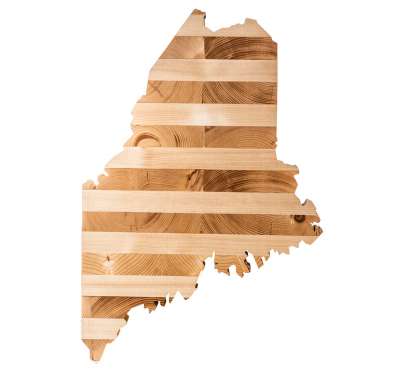
A cross-section of a 17-layer spruce CLT panel reminds researchers at the ASCC where the wood comes from. The majority of testing involves panels of three, five, and seven layers. Image courtesy of Michele Stapleton
We now know that all of those modern buildings have taken enormous energy to make. A sense of urgency about climate change is motivating people from sectors as diverse as architecture, conservation, forestry, investment, and government to reconsider and reimagine building with wood. All wood sequesters carbon as it grows, but firewood, chips, pellets, and liquid fuel, while renewable, all release carbon when they are burned. Lumber and mass timber are different. They consume – and store – carbon dioxide. New forms and combinations of wood are overcoming historic limitations on building heights and the paucity of large trees. There is particular excitement about the promise of cross-laminated timber (CLT).
Cross-laminated timber consists of massive panels made from layers of wood glued together in crisscross or “orthogonal” fashion, so the fibers alternate direction. The perpendicular arrangement contrasts with other forms of engineered wood, in which the fibers are primarily parallel, such as nail-laminated timber, laminated strand lumber, and glued laminated timber (glulam). Imagine plywood made with two-inch lumber instead of veneer, three layers, five layers or nine layers thick and incredibly strong. It has been described as “plywood on steroids.”
When it comes to building, this strength translates into height. CLT makes the wooden skyscraper possible. And demand for tall buildings is increasing with a growing and urbanizing world population. This demand, combined with concerns about climate change, is pushing CLT into the spotlight.
CLT isn’t new, or little known. It’s been around for almost 30 years. Developed in Switzerland and Austria in the 1990s, CLT panels are used for walls, floors, and roofs, often together with glulam beams and columns. Its use as a mid-rise and high-rise building material, though, is more widespread abroad than it is here at home. More than 500 mass timber buildings have been built in England alone, including Murray Grove, “the original timber tower,” a nine-story residential building raised in London in 2009. Since then, the contest to build the largest, tallest, most-wood structure has spread around the world. At 280 feet, the Mjøstårnet in Norway is currently the world’s tallest timber building. In Japan, Sumitomo Forestry has announced a plan to construct a 70-story hybrid timber skyscraper to mark the company’s 350th anniversary in 2041.
In North America, British Columbia has led the way. An 18-story dormitory completed at the University of British Columbia in 2017 sparked a spate of plans for other wood-framed high-rises in Vancouver. United States builders have started cautiously with smaller structures – four stories here, seven stories there. In 2017, in Portland, Oregon, “Carbon 12,” an eight-story (85-foot) glulam-and-CLT tower with a steel core, became the tallest wood-framed building in the United States.
As acceptance of mass timber grows among American builders, developers, and policy makers, CLT is gradually making its way into state and local building codes. In addition to its environmental benefits, contractors, carpenters, insurance companies, and property owners like it because the panels are relatively lightweight and quick to assemble. While material cost is generally higher than with traditional construction, parts of a CLT building can be prefabricated to millimeter-level precision off-site, delivered, and put together in a fraction of the time of steel and concrete, on smaller foundations, with smaller cranes and with smaller crews – especially good news in places where labor costs are high and construction jobs are difficult to fill, and in cities that want construction sites with minimal footprint, noise, and traffic.
Promoters have called CLT a “true wonder material,” “the building blocks of the future,” and the “great wood hope” that is ushering in a new timber age. Whatever its true potential, its spread in popularity has opened up an intriguing – and possibly lucrative – market for the beleaguered wood-products industry in the Northeast.
Building Better Wood
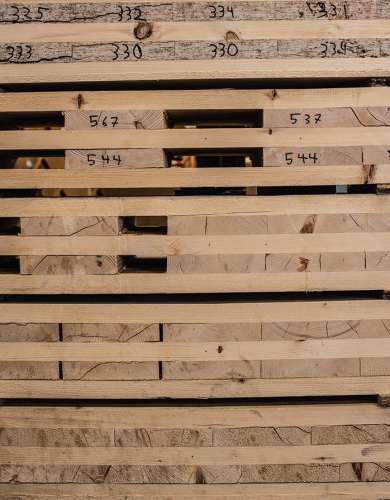
Visible cracks and checking are signs of failure. Every board is individually numbered and tested before becoming part of a cross-laminated panel. Image courtesy of Michele Stapleton
“I’m the wood guy here,” says Russell Edgar, Senior Lab Operations and Wood Composites Manager at the University of Maine’s Advanced Structures and Composites Center (ASCC) in Orono, where students, faculty, and researchers have been working on mass timber for the last 20 years and CLT for the last six.
The Center, itself built of mass timber, is an enormous warehouse-like complex, with high ceilings that accommodate industrial-scale machinery: giant presses and extruders; a wind-and-wave basin; the world’s largest 3-D printer. There are bridges, boats, and blades for wind turbines – and in one corner, pallets of Maine lumber stacked and ready to be made into CLT and tested: red, black, white, and Norway spruce; balsam fir; red pine; and jack pine.
Around the world, researchers are evaluating the use of different species in CLT for stiffness, acoustics, seismic performance, fire resistance, and moisture tolerance: Australian radiate pine, Tasmanian eucalyptus, Brazilian bamboo, Japanese cedar, Canadian eastern hemlock, Oregon Douglas fir, Alabama yellow pine.
But Northern Forest trees give the region an advantage: red and white spruce and balsam fir, especially, are well suited for CLT, and local mills are already cutting the component lumber. These species are part of the spruce-pine-fir south (SPF-S) lumber grouping that is already qualified for use in CLT. “Other regional species or groupings, such as hardwoods and Eastern white pine, may be evaluated for use in the future,” says Edgar. “But for now, they aren’t considered competitive compared to SPF-S from a mechanical or cost perspective.” White pine is less stiff and strong. Hemlock is difficult to dry cost effectively and without defect. (CLT lumber needs to be kiln-dried to 12 percent moisture for optimum adhesion.)
“In Quebec, they make CLT of black spruce that is small (four-inch diameter) but really old, so the grain is tight, the wood dense and strong,” Edgar explains. “However, the SPF-S lumber from Maine is also plenty stiff and strong, and an excellent resource for CLT.” Edgar says their research aims to qualify machine stress-rated SPF-S lumber, which would place it among the highest strength values in the CLT standard and make Maine-made CLT competitive against the strongest lumber in North America.
Edgar supervises teams of students, engineers, and technicians researching these species’ attributes when used in mass timber. The basic idea of a wood composite is to overcome the faults of raw wood. The testing here includes bending, pulling, and squeezing 8-by-40-foot panels in all directions, often until the wood breaks or tears. “Knots and other imperfections in a single member become less significant when spread out and randomized in a composite,” he explains. Alternating the grain gives CLT strength and stability in multiple dimensions.
Next to the piles of lumber are panels of three- and five-ply CLT, and panels with varying gaps in the core layers, which use less material, are lighter, and offer the ability to use the spaces for thermal or acoustical wood-fiber insulation, according to Edgar. Researchers here have found that including other forms of Maine-made wood composites, such as a layer of laminated strand lumber (made in Houlton, Maine by Louisiana Pacific) sandwiched in a middle layer increases a panel’s overall strength by up to 25 percent. They are also testing the durability of the critical “bondline” (where pieces are glued together) for resistance to heat and moisture stress.
CLT becomes cost-competitive in buildings of 6- to 14-stories, and works best in the 8- to 12-story range. The international building code will soon prescriptively allow wood buildings 18 stories tall. While the United States won’t adopt this provision until 2021, Edgar hopes the ASCC testing being done here in Orono will convince officials in Maine to adopt tall wood provisions early, as Washington and Oregon have done.
University R-and-D programs have a tendency toward redundancy and failed promises. Maine, for instance, is still waiting for widespread adoption of wood-based fuels, in development since 2006 with more than $15 million in public funds invested. And academic research is often too slow to match the pace of global change. But a college campus has been an ideal proving ground for CLT.
Says Edgar, “The enthusiasm for mass timber that’s out there is unlike anything I’ve seen in 20 years of working in this field.”
The New Old Material
Andrea Leers and Jane Weinzapfel started their architectural firm in 1982. “We were both interested in working in the public realm, designing structures for urban settings that people could enjoy,” says Leers. Their office is on the third floor of the Hudson Building, on the edge of Boston’s Chinatown. Built in 1928 in an art deco style, the 14-story steel structure has a façade of brick and cast concrete panels and a brass-trimmed entrance.
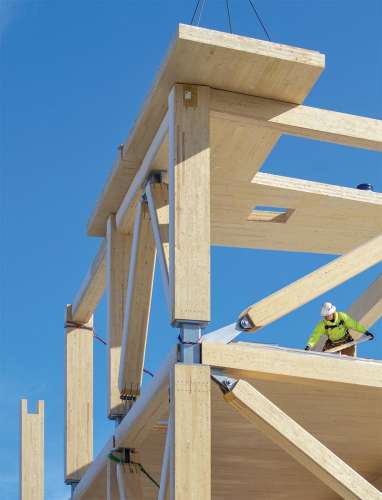
The structural frame of the Olver Design Building, consisting of glulam posts and beams and cross-laminated timber (CLT) plates. Photo credit: Alex Shreyer/UMASS
Leers Weinzapfel Associates had no experience with mass timber when they designed a steel-and-concrete building for the University of Massachusetts Amherst: a new home for faculty of architecture, landscape architecture, regional planning, and building and construction technology, who previously were scattered all over campus. But then two professors in the latter program, Peggi Clouston and Alex Schreyer, spoke up and convinced the school to use mass timber instead.
“We advocated wood for all the environmental benefits that wood brings (embodied carbon and less pollution in manufacture, and so on) but also for forest health reasons,” says Clouston. “Market incentives, like CLT, help defray the cost of forest management practices. So we reached out to former Massachusetts congressman John Olver to help secure government funds to make it a Mass Timber Demonstration Building. And that switched the design from steel to wood.”
Leers and her team were unfazed by the switch. And once they learned more about mass timber, they got super excited. “Everyone knows and loves wood,” says Leers. “Natural materials have a human comfort and desirability, a warmth of appearance, that nothing else does.” Their enthusiasm propelled them up a steep learning curve as the glulam frame, CLT and concrete composite floors, and CLT walls and staircase began to form offices, studios, and classrooms around a green roof and skylit commons. They clad the exterior in a light metal jacket of copper-colored anodized aluminum. Inspired by the forests and tobacco barns of the surrounding Connecticut River Valley, the building shows the wood on the inside, where the people are.
“We’re beyond happy with how it turned out,” says Clouston. “It truly is an exemplary teaching and research facility that inspires the next generation of design professionals. The exposed wood is beautiful and allows our students to see and understand the actual structure. People (sometimes even those unaffiliated with the building) walk in just to admire the architecture.”
“It’s a beautiful building,” says Leers, who calls wood “the new old material.” Photographs of the UMass building hang on the firm’s wall, and a scale model is on display in the foyer. Samples of CLT sit on the windowsill and nearby floor. “Wood has a different aura, a very primitive appeal,” says Leers. “It brings people closer to nature in our emotional lives. That’s why it’s so powerful.”
At the end of 2019, as competition to build with mass timber seemed to be intensifying, Leers Weinzapfel Associates led a national team of architects and engineers in the completion of Adohi Hall, a 700-bed, five-story student housing complex at the University of Arkansas. Made of spruce-pine-fir CLT from Austria with local cypress trim, the 2-million-square-foot project became the largest mass timber building in the United States.
“It is a race,” says Edgar. “We think it’s very likely that CLT is going to be successful in the United States, including the Northeast. We see it as an opportunity for Maine’s forest products industry. As urban demand for timber buildings goes up, we’re in a position to supply CLT sustainably.”
In a recent national survey, US structural engineering firms rated CLT highly for its aesthetic characteristics and for environmental and structural performance, but lack of availability prevented them from using it more consistently.
Companies are poised to build more production facilities once they are confident there is demand. Yet builders hesitate because there’s not currently a local supply. “It’s a chicken-and-egg thing,” says Edgar. “Something’s gotta give.”
UMaine’s ASCC is two years into a grant from the federal Economic Development Administration (EDA) that created the Mass Timber Commercialization Center, a hub for 50 regional stakeholders interested in seeing mass timber flourish in the region. By their calculations, a single CLT plant would use 50 million board feet a year. Maine’s current annual output is approximately 500 million board feet of lumber, meaning a single CLT mill would increase the market for SPF-S lumber by ten percent. Given current demand, there’s likely only room for one or two plants in the state.
Several new CLT factories have been announced but are yet to be built, including one by North Carolina–based LignaTerra at a former paper mill in Lincoln, Maine. But much uncertainty remains; Montana-based SmartLam withdrew its proposal for a Maine CLT plant last year.
Back to the Woods
The West Coast may have bigger trees, and the Southeast faster-growing trees, but the Pine Tree State is the most heavily forested state in the nation, and close to the densely urbanized Northeast corridor. That proximity may be key to future growth in this part of the country, because reduced carbon emissions are an important part of the motivation for using CLT in the first place.
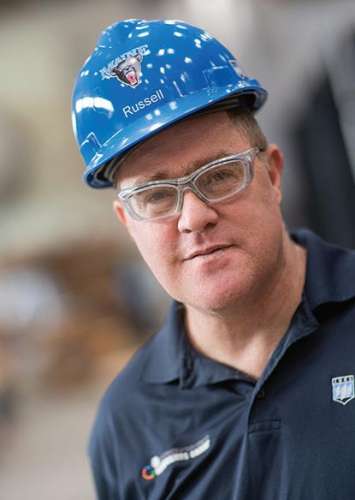
“The enthusiasm for mass timber that’s out there is unlike anything I’ve seen in 20 years of working in this field.” Russell Edgar, Senior Lab Operations and Wood Composites Manager, University of Maine. Image courtesy of Michele Stapleton
Making it easier for builders and designers to locally source CLT and other wood is the focus of Local Wood WORKS, an initiative of Kennebec Land Trust, Maine Forest Service, Coastal Enterprises, Inc., Maine Coast Heritage Trust, The Nature Conservancy, GrowSmart Maine, and the Northern Forest Center. “People are waking up to the idea that we can substitute wood for other materials,” says Project Manager Lee Burnett. “And if we use wood in a sustainable way, it’s good for the climate and local economies.” He has found that locally sourced wood has much more resonance than green certifications, which Maine has put a lot of effort into with unsatisfying results.
Burnett thinks that if people know their building’s material comes from a place nearby, maybe they will feel more connected to Maine’s forests. “If we can get people to want part of the Maine woods in their homes, they may have more interest in preserving the forest.”
Many organizations share Burnett’s desire to preserve working forests and their related culture and economy, which is why the New England Forestry Foundation, Forests for Maine’s Future, Highstead Foundation, and a coalition of industry partners, communities, and government agencies that drafted the April 2019 Forest Opportunity Roadmap for Maine all recommend CLT as a way to increase forest stewardship.
For each day between 1990 and 2010, 77 acres of New England forests were converted to some type of non-forest use. A 2017 region-wide study by the Harvard Forest estimated that, at current rates, New England will lose 1.2 million acres of forest cover during the next 40 years.
Expanded use of CLT could increase the value of working forestland and slow or reverse this loss, all while addressing climate change and a need for urban dwellings.
“CLT is really important because it means we are using the forest for long-term products that can help us store carbon,” says Ivan Fernandez of the University of Maine School of Forest Resources and Climate Change Institute and a member of the Maine Climate Council. According to Fernandez, growing our working forests, and growing more forest, can enhance our response to climate change. “We have the capacity to grow more wood per acre. We can do that by letting the overall age of stands get older, and along the way harvest smaller trees sustainably. We can build with mass timber and still leave a lot of the bigger trees in the forest. The role that CLT can play has never been more important than now, if we consider our carbon-solution goals, especially between now and 2050.”
Finding the Answer in Nature’s Structure
In 1967, the carbon dioxide concentration in Earth’s atmosphere was 322 parts per million and increasing, but few were paying attention. That year, the State University of New York College of Environmental Science and Forestry (SUNY ESF) hosted a symposium on Design and Aesthetics in Wood. Architect Carl Koch bemoaned the growing scarcity of wood in the built environment, and worried about extinction of the Eastern forest. “The chief characteristic of wood as a material has always been its adaptability,” he said, pleading with his peers to stop hiding wood inside walls.
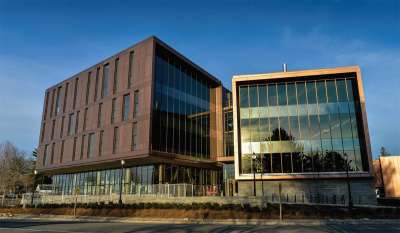
The Olver Design Building as seen from the west. Photo credit: Alex Shreyer/UMASS
Architectural scholar Reyner Banham reported that wooden forms were fading away as people favored newer materials. “The ancient familiarity with natural woodland” was fast disappearing from the areas within reach of the ordinary citizen, he warned. He encouraged a return to wood as “an essential part of the cultural inheritance.”
Art professor George F. Earle said, “The need to reintroduce warmth and human scale into a world gone cold and brutally monotonous cries out not for a return to tradition but for a reworking of those elements, materials, and forms that have always enriched life.”
The innovative architect and futurist R. Buckminster Fuller was in attendance. In a long and rambling speech he proclaimed, “Our tree is the greatest structure I know.”
If those speakers were alive today, they would rejoice in seeing the Olver Design Building at UMass and the wooden towers rising toward the skies above Vancouver and Norway, and in the millions of acres of living, growing forest in the region.
CLT and other mass timber buildings showcase what many in forest science and industry perhaps take for granted, surrounded as they are all day by bark, cambium, rings upon rings telling time, the smell of sap and resin, the satin finish of boards sanded smooth. They know that if cellulose can hold up an 80-foot, 150-year-old spruce, then surely the very same fibers fused of sun, soil, and rain, slightly rearranged, can hold up a multistory building. For others, experiencing wood on a college campus or a crowded city block may be a rediscovery of shelter – ancient, familiar, and close at hand.
To those concerned about the fate of the climate and the resilient forests of the Northeast, a wooden skyscraper is also, perhaps, a glimpse of a hopeful future.
Journalist and science writer Catherine Schmitt is the author of three books. She is the Science Communications Specialist for the Schoodic Institute at Acadia National Park.